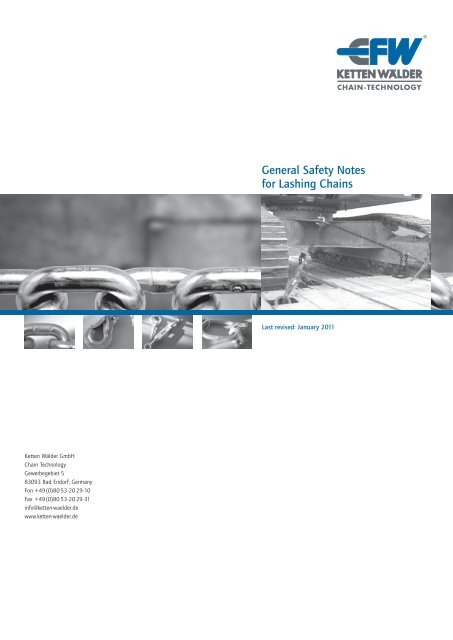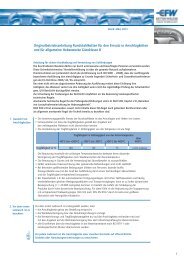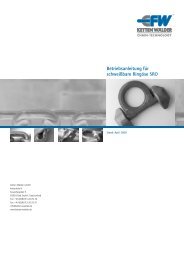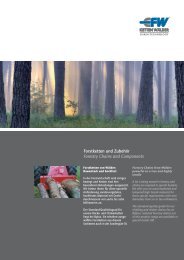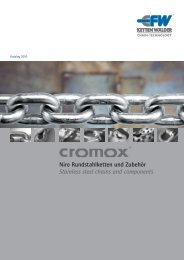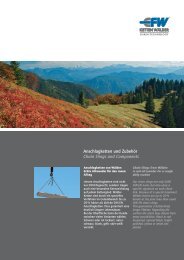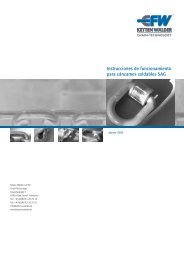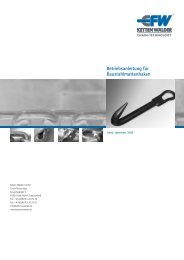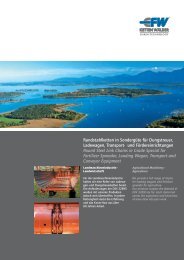General Safety Notes for Lashing Chains - Ketten Wälder
General Safety Notes for Lashing Chains - Ketten Wälder
General Safety Notes for Lashing Chains - Ketten Wälder
You also want an ePaper? Increase the reach of your titles
YUMPU automatically turns print PDFs into web optimized ePapers that Google loves.
<strong>Ketten</strong> <strong>Wälder</strong> GmbH<br />
Chain Technology<br />
Gewerbegebiet 5<br />
83093 Bad Endorf, Germany<br />
Fon +49 (0)80 53-20 29-10<br />
Fax +49 (0)80 53-20 29-31<br />
info@ketten-waelder.de<br />
www.ketten-waelder.de<br />
<strong>General</strong> <strong>Safety</strong> <strong>Notes</strong><br />
<strong>for</strong> <strong>Lashing</strong> <strong>Chains</strong><br />
Last revised: January 2011
1. Conditions of use:<br />
2. Application:<br />
3. Remaining<br />
hazards:<br />
2<br />
d<br />
<strong>General</strong> <strong>Safety</strong> <strong>Notes</strong> <strong>for</strong> <strong>Lashing</strong> <strong>Chains</strong><br />
Instructions <strong>for</strong> safe handling and avoidance of danger.<br />
This user in<strong>for</strong>mation/manufacturer's declaration must be kept <strong>for</strong> the entire utilisation time.<br />
We hereby declare (supported by the certification DIN EN ISO 9001 – 2008) that the following specification<br />
is based on the corresponding safety and health requirements of the EC guidelines. Any changes of the<br />
product that have not been agreed upon be<strong>for</strong>e with <strong>Ketten</strong> <strong>Wälder</strong> make this specification invalid.<br />
The specification will also become invalid if the product has not been inspected in regular intervals.<br />
The product shall only be used if:<br />
•The lashing <strong>for</strong>ces are known and they do not exceed the maximum admissible lashing <strong>for</strong>ces<br />
indicated on the tag, with possible shock and/or cyclic loads being taken into account.<br />
•It can be made sure that the stress resulting from the lashing <strong>for</strong>ces applied acts only axially to the<br />
spindle of the ratchet tensioner, i.e. only freely hanging in pulling direction. Any bending stress has<br />
to be ruled out as it may lead to damage.<br />
•A visual and functional inspection is to be per<strong>for</strong>med prior to repeated use. It has to be made sure that<br />
the spindles move easily within the travel range and that no de<strong>for</strong>mation, cracks or other signs of<br />
damage are visually noticeable. In the event of apparent damage, the device must not be used any more!<br />
•<strong>Lashing</strong> chains and ratchet tensioners must not be used <strong>for</strong> lifting loads.<br />
•The size of the appropriate lashing chain and ratchet tensioner(s) to be used <strong>for</strong> the <strong>for</strong>ce to be<br />
taken up is to be chosen in dependence of the lashing <strong>for</strong>ces required <strong>for</strong> that purpose and the<br />
type of application. Use long-link chains only <strong>for</strong> logs!<br />
•The ratchet tensioner must be lashed with the manual lever (approx. 50 kg) and not with the<br />
help of a tube extension or similar.<br />
Right way Wrong way<br />
•For safety reasons, the travel range of the spindles is limited according to size.<br />
Maximum tensioning travel distances are:<br />
u 75 mm <strong>for</strong> size 6 (1/4”) with 6 mm chain<br />
u 150 mm <strong>for</strong> size 8 (5/16”) with 8 mm chain<br />
u 150 mm <strong>for</strong> size 10 (3/8”) with 10 mm chain<br />
u 130 mm <strong>for</strong> size 13 (1/2”) with 13 mm chain<br />
These limits are only reached if both spindles are extended to the stop.<br />
Caution! Exceeding the range of travel by using <strong>for</strong>ce will damage the locking<br />
mechanism as well as the thread, rendering the ratchet tensioner uselers.<br />
User In<strong>for</strong>mation<br />
•The selected lashing chains must be both strong and long enough to suit the intended<br />
application, and they must also have the right length with respect to the method of lashing<br />
<strong>for</strong> which they are going to be used. The standard EN 12195 - 1: 2008 serves as a basis.<br />
•Due to differences in behaviour it is not admissible to use different types of lashing equipment<br />
(e.g. lashing chains and lashing straps) <strong>for</strong> lashing down one and the same cargo.<br />
•Be<strong>for</strong>e unfastening, it has to be made sure that the load will stand safely and that it does not shift.<br />
•If safety catches are available they have to be used.<br />
•In order to guarantee safe functioning and to reduce wear and tear, the mechanically moveable parts<br />
of the ratchet tensioners are to be lubricated with grease or oil in dependence of the frequency of use.<br />
•Correct application ensures the prevention of physical damage to oneself and other persons.<br />
Faulty application may lead to serious injuries.<br />
•Beware of low hanging overhead cables while loading and unloading.<br />
•Relevant applicable regulations, rules and directives <strong>for</strong> the securing of loads are to be observed.<br />
•Damage due to sharp edges or the like have to be excluded by appropriate protective measures.<br />
•Ratchet tensioners are to be positioned in such a way that proper footing and balance<br />
can be ensured during operation (the operator is NOT to stand on the cargo!).<br />
•It is not admissible to use lashing chains that have been knotted together or joined with bolts or screws.<br />
•Operating instructions are to be kept accessible <strong>for</strong> all operators and are to be observed.<br />
•Danger when loosening the lashing chains.<br />
•Danger of possible blowback by the manual lever.


